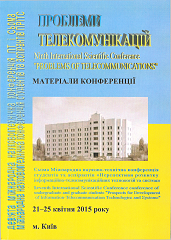ВИБІР МЕТОДУ УПРАВЛІННЯ ТРАФІКОМ В ПАКЕТНИХ МЕРЕЖАХ
Анотація
Selection of traffic management method in packet-switched networksThis article deals with the methods of traffic management in packet-switched networks. It is demonstrated that those methods are insufficient for channel reservation, load balancing and overload prevention. MPLS-TE is described in this article as a solution for the problems stated above.Посилання
Семенов Ю.А. «Телекоммуникационные технологии». – «Москва», 2014. – 600с.
А.Б. Гольдштейн, Б.С. Гольдштейн «Технологія і протоколи MPLS». – «БХВ – Санкт-Петербург», 2005. – 306с.
Вивек Олвейн «Структура и реализация современной технологии MPLS», «Москва», 2010 г. – 606с.
##submission.downloads##
Як цитувати
Гаттуров, В. К., & Ципанов, В. О. (2017). ВИБІР МЕТОДУ УПРАВЛІННЯ ТРАФІКОМ В ПАКЕТНИХ МЕРЕЖАХ. Збірник матеріалів Міжнародної науково-технічної конференції «ПЕРСПЕКТИВИ ТЕЛЕКОМУНІКАЦІЙ». вилучено із https://conferenc-journal.its.kpi.ua/article/view/103173
Номер
Розділ
2015 Передавання інформації в телекомунікаційних системах нового покоління
Ліцензія
Авторське право (c) 2017 Віктор Кавіч Гаттуров, Володимир Олександрович Ципанов

Ця робота ліцензується відповідно до Creative Commons Attribution 4.0 International License.
Authors who submit to this conference agree to the following terms:a) Authors retain copyright over their work, while allowing the conference to place this unpublished work under a Creative Commons Attribution License, which allows others to freely access, use, and share the work, with an acknowledgement of the work's authorship and its initial presentation at this conference.
b) Authors are able to waive the terms of the CC license and enter into separate, additional contractual arrangements for the non-exclusive distribution and subsequent publication of this work (e.g., publish a revised version in a journal, post it to an institutional repository or publish it in a book), with an acknowledgement of its initial presentation at this conference.
c) In addition, authors are encouraged to post and share their work online (e.g., in institutional repositories or on their website) at any point before and after the conference.

